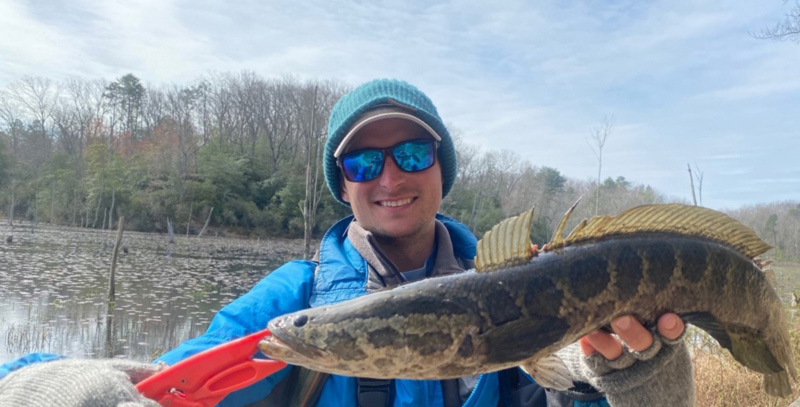As the summer sun starts to hang lower in the sky and autumn begins to move in, our tactics for targeting snakeheads need to change. Keeping in mind that the optimum water temperature range for snakehead is from 50 degrees up to 80.6 degrees Fahrenheit, we’ll need to adjust our tactics as the water temperature drops in the fall.

I have fished for snakehead as late as October, but catching them that late in the year can be a challenge. I have also noticed that the snakehead I’ve caught late in the year tend to be smaller fish. The fish at this time of year have moved away from their shallow summer haunts and are seeking out deeper water. This normally occurs when the days become shorter and the grass and lily pad fields are dying off.
What’s happening during this phase of the season is the snakehead are following the bait and are trying to fatten up for their winter rest. You’ll find them off points of land, deeper water stump fields, dying grass beds, and hard cover. These locations are similar to where you find them in the spring, just before they move up into the feeder creeks and then into very shallow water. Remember, snakeheads are apex predators and they are looking for baitfish. They are seeking out locations where they can push the baitfish to trap them, as well as places to hide and ambush a meal.
You’ll also find the bait off points of land where they are seeking cover and an escape route to deeper water. Usually these are points that are found at the mouths of feeder creeks which flow into a main body of water. You will need to follow the wind, too — fish the windward side of points and windblown shorelines. Baitfish will get pushed up against the bank by the wind, or perhaps they are following their food supply that’s getting pushed up just the same, such as algae, phytoplankton, zooplankton, or even smaller fish.
In tidal waters you also still need to follow the ebb and flow of the tide as you would in the summer. Snakehead will follow the tide into shallower areas, again following the bait. Baitfish will ride the tide up to safer cover, though it will not be the same very shallow waters as summer depths. Still, baitfish will be found along grassy shorelines and flats with hard cover such as stump fields, laydowns, and rocks.
Let’s be real, snakehead are fish that have an attitude and it’s not in the best interest of other fish to be around when snakeheads are hungry, including other snakeheads. Snakehead will eat just about anything that swims past them and they are known to eat prey up to a third of their body length. Therefore, the baits I use for snakehead in the fall are swim jigs, chatterbaits, weedless rigged fluke, lipless crankbaits, and minnows.

Cold weather, or rather colder water, slows the fish’s metabolic rate and oxygen demand. For this reason I will fish my baits a bit slower with coloration towards a gray or brown or a combination of the two. Try to match the bait in the area.
In the fall you will get fewer reaction strikes and more feeding strikes at your baits. The fish are eating and getting ready for winter when they will be eating even less. You’ll also notice that you will have more missed strikes than you do during the summer. So again, slow things down. Wait to set the hook and allow another second or so for the fish to take the bait. And if you’re fishing minnows, let the fish run with the bait for a second or two before setting the hook.
On those autumn days when the sun is high in the sky and the temperature has been warmer for a few days you’ll want to fall back to your summer tactics. Fish farther up in the shoreline weed cover and a short distance up into the creeks. The heat will draw the bait back up into the shallower water where they will be feeding on the last of the summer insects. As we all know, snakehead are lovers of warm water. So that sunshine will draw them shallow again as they are following the bait. Warm spells mean you will want to throw a small topwater frog or mouse back up in the weeds as you did during the warmer months, too.
Many snakehead anglers fish with minnows, and autumn is prime minnow season. Rig your minnow under a bobber keeping the bait six or so inches off the bottom. Sometimes you will see bubbles as they eat your bait; remember to wait a second or two before setting your hook and you will have a better shot at hooking up.
Something that needs considered before you head out to your favorite snakehead fishing hole this fall is to check to be sure that the location you’ve chosen is still open. Autumn is the start of duck hunting season and some of the waterways will be closed to fishing. (Note that much of Blackwater is closed to boat traffic). This of course is for your safety, and so as to not scare of any potential waterfowl from entering the area for hunters.
Last thought on fall snakehead fishing: keep at it, slow things down, and if all else fails tie on a minnow.
-By Eric Packard